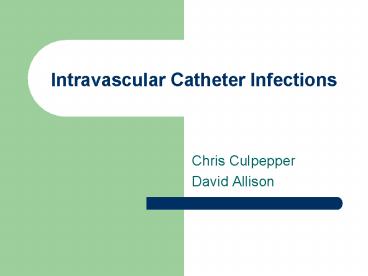Intravascular Catheter Infections - PowerPoint PPT Presentation
1 / 14
Title:
Intravascular Catheter Infections
Description:
Intravascular Catheter Infections. Chris Culpepper. David Allison ... O'Grady et al. Pediatrics. Vol110, Num 5, Nov 2002. Totally Implantable - Introduction ' ... – PowerPoint PPT presentation
Number of Views:236
Avg rating:3.0/5.0
Title: Intravascular Catheter Infections
1
Intravascular Catheter Infections
- Chris Culpepper
- David Allison
2
Overview
- Intravascular catheters provide necessary
vascular access in patients who require both
short-term and long-term medical therapy - Short-term therapy utilizes peripheral IV access
- Long-term therapy can utilize either peripheral
vs. central IV access
3
Overview
- Types of Catheters
- Peripheral Venous Catheter
- Peripheral Arterial Catheter
- Midline Catheter
- Nontunneled CVC
- Pulmonary Artery Catheter
- PICC
- Tunneled Catheter
- Totally Implantable
- Umbilical Catheter
4
PICC vs. Port
- PICC PORT
5
PICC Line - Introduction
- What is it?
- Peripherally Inserted Central Catheterization
- ENTRY SITE Inserted into basilic, cephalic, or
brachial veins and enter the SVC - LENGTH 20 cm or longer, depending on patient
size - COMMENTS Requires catheter site care Lower
rates of infection (0.4 - 2.4) Can remain for
weeks to a year with proper maintenance - Guidelines for the prevention of intravascular
catheter-related infections. OGrady et al.
Pediatrics. Vol110, Num 5, Nov 2002
6
Totally Implantable - Introduction
- Port-a-cath
- ENTRY Tunneled beneath skin and have devices
subcutaneous port accessed with a needle
implanted in subclavian or internal jugular vein - LENGTH 8 cm or longer
- COMMENTS Lowest risk for catheter-related
bloodstream infection (CRBSI) (0.05 - 0.18)
improved patient self-image no need for local
catheter site care can remain for years surgery
required for catheter removal - Guidelines for the prevention of intravascular
catheter-related infections. OGrady et al.
Pediatrics. Vol110, Num 5, Nov 2002
7
Complication
- Infection, Infection, Infection!!
- The use of either peripheral or central IV access
puts patients at increased risk for local or
systemic infections, including - Local site infection, CRBSI, septic
thrombophlebitis, endocarditis, and other
metastatic infections (lung abscess, brain
abscess, osteomyelitis, etc.) - Guidelines for the prevention of intravascular
catheter-related infections. OGrady et al.
Pediatrics. Vol110, Num 5, Nov 2002
8
Infection Pathways
- Migration of skin organisms
- Contamination of catheter hub intraluminal
infection - Hematogenous seeding
9
Prevention of Infection
- Materials Teflon, Silicone, and Polyethylene are
more resistant to attachment of microorganisms - Sterile technique when placing catheters
- Catheter site Femoral more prone to infections
- Catheter securement (Tegaderm less prone to
infection than sutures) - Systemic prophylactic antibiotics
- Regular catheter exchanges not helpful at
reducing infection rates - Impregnated Catheters
- - Chlorhexidine/Silver Sulfadiazone
- - Minocycline/Rifamptin (best)
- - Platinum/Silver
- Guidelines for the prevention of intravascular
catheter-related infections. OGrady et al.
Pediatrics. Vol110, Num 5, Nov 2002
10
Catheter-related Infection
- Most Common Pathogens isolated from catheter
related bloodstream infections - Coagulase-negative staph 37
- S. aureus 13
- Enterococcus 13
- Gram-negative Rods 14
- E. coli 2
- Enterobacter 5
- P. aeruginosa 4
- K. pneumoniae 3
- Candida species 8
- Guidelines for the prevention of intravascular
catheter-related infections. OGrady et al.
Pediatrics. Vol110, Num 5, Nov 2002
11
Special Circumstances
- Gynocologic oncology patients have a much higher
rate of infection from PICC lines versus
subcutaneous ports (29 vs 9.8) - Malfunction and complication requiring removal
also favored subcutaneous ports - Complications of indwelling venous access devices
in patients with gynecologic malignancies. Estes
et al. Gynecologic Oncology, Dec 2003 pp 591-595
12
Treatment Regimens
13
Medications
- Coag-negative Staph or Staph Aureus
- MSSA - Nafcillin or Oxacillin
- MRSA Vanc, Clinda, Linezolid
- E. faecalis/ E. faecium
- Amp/Gent
- If Amp resistant - Vanc/Gent
- If Vanc resistant - Linezolid or Quin/
Dalf - E. coli and Klebsiella - Third-generation Csp
- Guidelines for the Management of Intravascular
Catheter-Related Infections Clinical Infectious
Disease Vol 32,Number 9, May 2001
14
Medications
- P. aeruginosa - Third- or fourth- generation Csp
or carbapenem or antipseudomonal ß-lactam (Tic,
Pip, Mez) aminoglycoside - Enterobacter - Carbapenem
- C. albicans or Candida - AmB or fluconazole
- Guidelines for the Management of Intravascular
Catheter-Related Infections Clinical Infectious
Disease Vol 32,Number 9, May 2001































